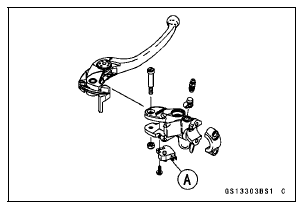


If it does not, adjust the brake light switch.
Switch Body [A] Adjusting Nut [B] Light sooner as the body rises [C] Light later as the body lowers [D]

NOTICE
To avoid damaging the electrical connections inside the switch, be sure that the switch body does not turn during adjustment.
If it does not go on, inspect or replace the following parts.
Battery (see Charging Condition Inspection in the Electrical System chapter) Brake Light (LED) (see Tail/Brake Light (LED) Removal Installation in the Electrical System chapter) Main Fuse 30 A and Brake Light/Horn Fuse 10 A (see Fuse Inspection in the Electrical System chapter) Front Brake Light Switch [A] (see Switch Inspection in the Electrical System chapter) Rear Brake Light Switch (see Switch Inspection in the Electrical System chapter) Harness (see Wiring Inspection in the Electrical System chapter)

 Brake Operation Inspection
Brake Operation Inspection Suspension
SuspensionValve-to-Guide Clearance Measurement (Wobble Method)
If a small bore gauge is not available, inspect the valve
guide wear by measuring the valve to valve guide clearance
with the wobble method as indicated below.
Insert a new valve [A] into the guide [B] and set a dial
gauge against the stem perpendicular to it as close as
possible to the cy ...
Battery Charging
Remove the battery from the motorcycle
(see Battery Removal).
Attach the leads from the charger
and charge the battery at a rate (amperage
x hours) that is indicated on
the battery. If it is not possible to read
the rate, charge the battery at an amperage
that is about 1/10th of the ...
Key Registration
Case 1: When the ignition key has been lost or additional
spare ignition key is required.
Prepare a new spare ignition key.
Cut the key in accordance with the shape of the current
ignition key.
Remove the rear seat (see Rear Seat Removal in the
Frame chapter).
Remove the immobilizer/K ...